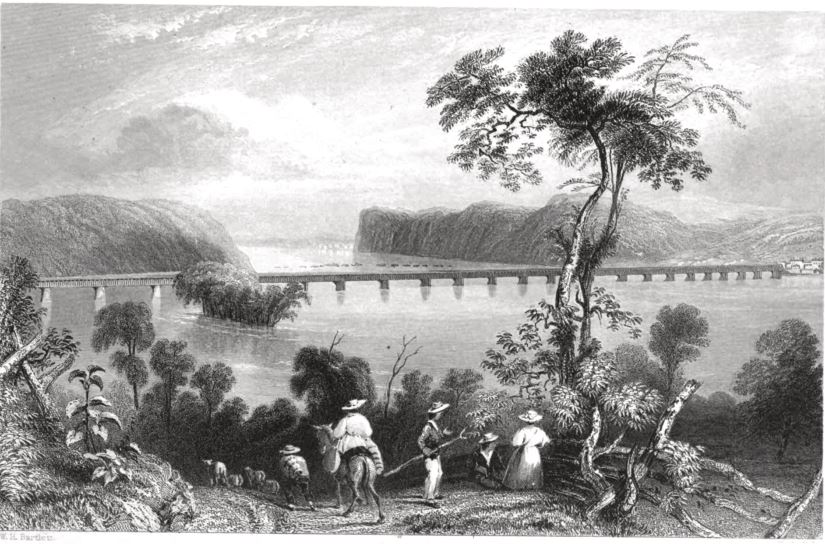
Covered bridge over the Susquehanna at Columbia-Wrightsville
from Picturesque American Scenery by Nathaniel Parker Willis (1883). [19]
Perhaps Mary Forry and Joseph Rohrer crossed the Susquehanna on this bridge.
1799 Mary Forrey was born on November 12, 1799, based on her death on November 22, 1885, at age 86y 10d. She was likely born in Hellam Twp, York County, Pennsylvania. [1] [2] Her parents lived in Hellam Twp, York County in 1798 [3] [4] [5] and 1800 [6].
1801 Joseph Rohrer was born on October 29, 1801, based on his death on June 5, 1884, at age 82y 7m 7d. [7] [8] [9] He was born at West Hempfield, Lancaster County, where his father, David Rohrer lived in 1800, perhaps. [10] [11]
1810 Joseph's father, David Rohrer lived in Hempfield Twp, Lancaster County, Pennsylvania with Males: one (age 0-10, son Joseph), two (age 10-15, son David and ?), one (age 45+, David) and females: one (age 16-25, daughter Mary, where was Anna age 12?), one (age 45+, wife Mary). [12] [13]
1828 Mary Forry and Joseph Rohrer were married. [14] [15] [16] [17] Their oldest child, Joseph, was born in Pennsylvania in 1829, so they were, perhaps, married in Pennsylvania about that time. At that time, Joseph Rohrer likely lived in West Hempfield Twp, Lancaster County and Mary Forrey likely lived in Hellam Twp, York County, which are adjacent to each other, but separated by the Susquehanna River. There was a covered bridge across the river at that time. [18]
Construction of the first Columbia–Wrightsville Bridge was begun in 1812 and completed December 5, 1814, by J. Wolcott, H. Slaymaker, S. Slaymaker at a total cost of $231,771, which was underwritten by the newly formed Columbia Bank and Bridge Company. The bridge was 5,690 feet (1,730 m) long and 30 feet (9.1 m) wide and had 54 piers and twin carriageways. Constructed of wood and stone, the covered bridge also included a wooden roof, a whitewashed interior and openings in its wooden sides to admit light and allow a view of the river and surrounding areas. It stood immediately south of the present-day Wright's Ferry Bridge along Route 30. Tolls were $1.50 (equivalent to $18.29 in 2019) for a wagon and six horses, and six cents for pedestrians (equivalent to $0.73 in 2019). It was considered the longest covered bridge in the world at the time. The bridge accommodated east–west traffic across the Susquehanna River for 14 years before being destroyed by ice, high water and severe weather on February 5, 1832.

1828 Two years before Joseph and Mary Rohrer moved to Canton, Ohio, the Ohio-Erie Canal, linking Lake Erie with Massillon (about 10 miles east of Canton) was near completion in Ohio. The opening of the canal may have influenced the Rohrer family's decision to move to Canton, Ohio. [20]
1829 Joseph Rohrer, son of Joseph Rohrer and Mary Fory, was born on December 24 in Pennsylvania. [21]
1830 Joseph Rohrer lived in West Hempfield, Lancaster County, Pennsylvania in a household with Males: one age 0-5 (son Joseph), one age 15-19, one age 20-30 (Joseph, himself), one age 70-80 (father David Rohrer?) and Females: one age 5-10 and two age 20-30. [22] [23]

1830 Joseph Rohrer and family moved from Lancaster County, Pennsylvania to two miles east of Canton, Stark County, Ohio, where they lived for 20 years. [25] [26] [27]
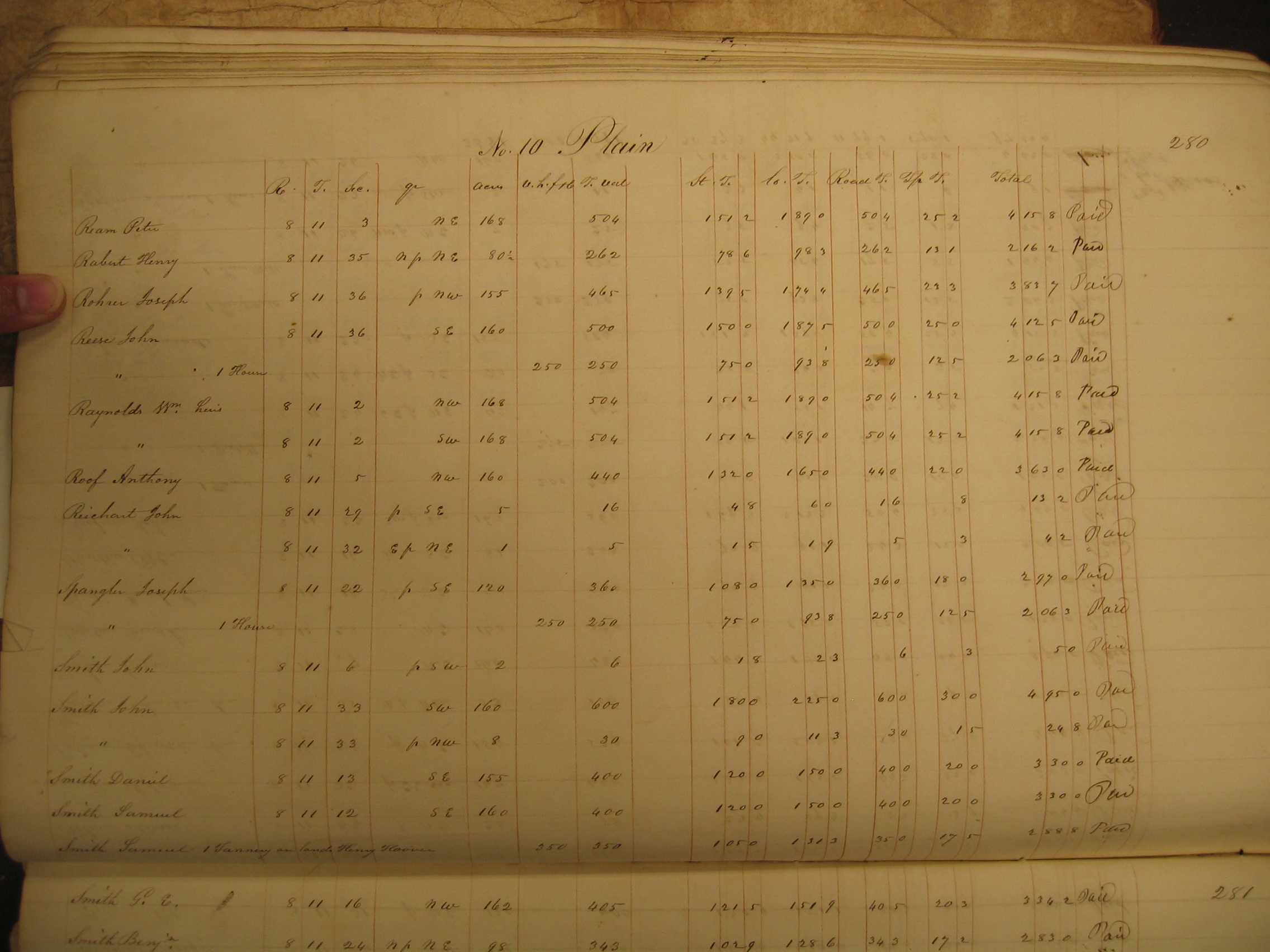
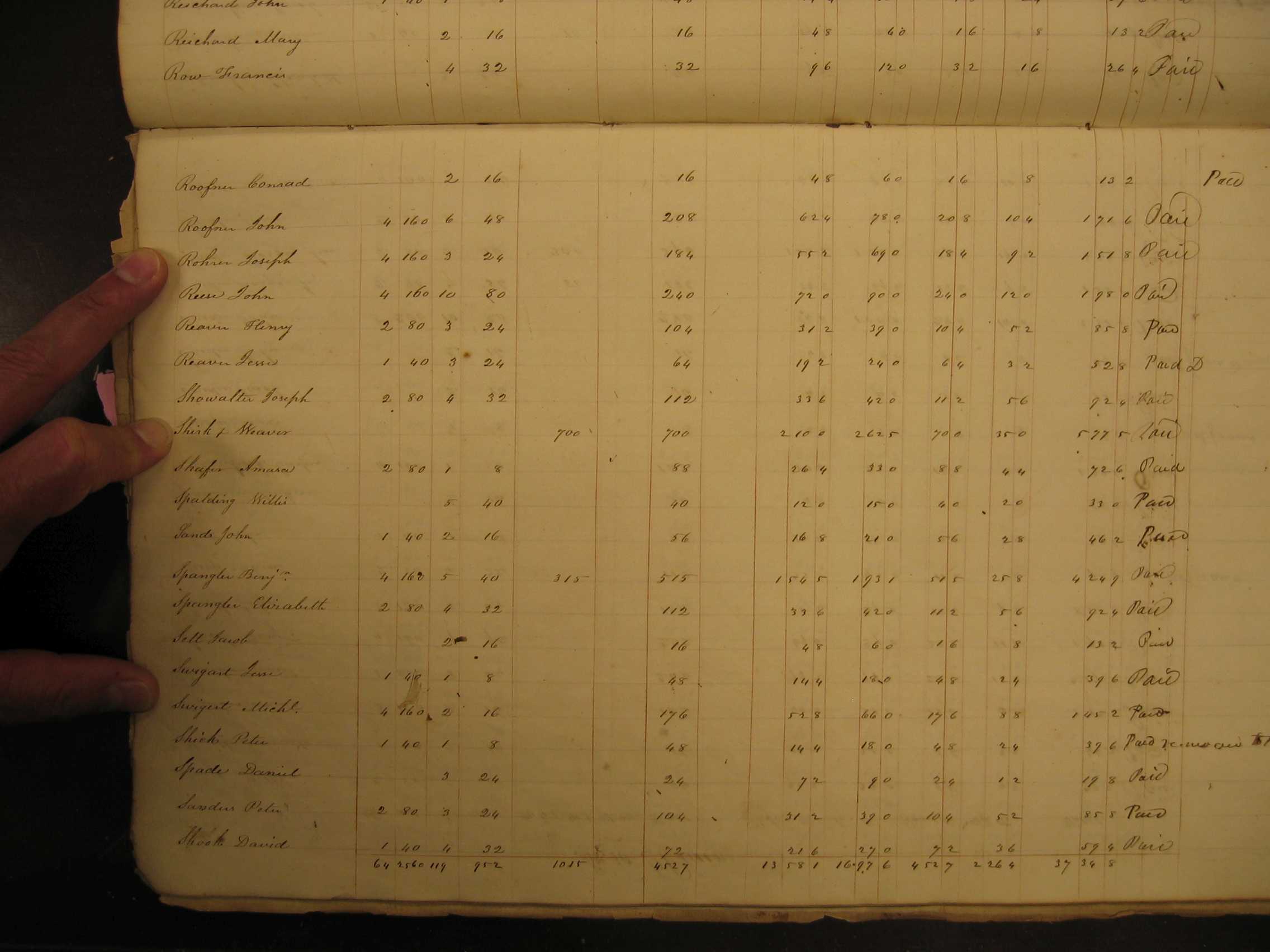
1830 Joseph Rohrer was ordained as the first preacher of the Rowland Mennonite Church just east of Canton, Ohio. [29] The church was on Tuscarawas Road in Canton Twp, Stark County, Ohio. One block north is Plain Twp, where tax records and census records indicate that Joseph lived. The first church members were Jacob Rowland and his wife, Mrs. David Schriver, Mrs. Henry Hull, and Christian Wengard and his wife. The original log church was torn down and replaced in 1875 by the present (still there in 2005) brick church. [30]
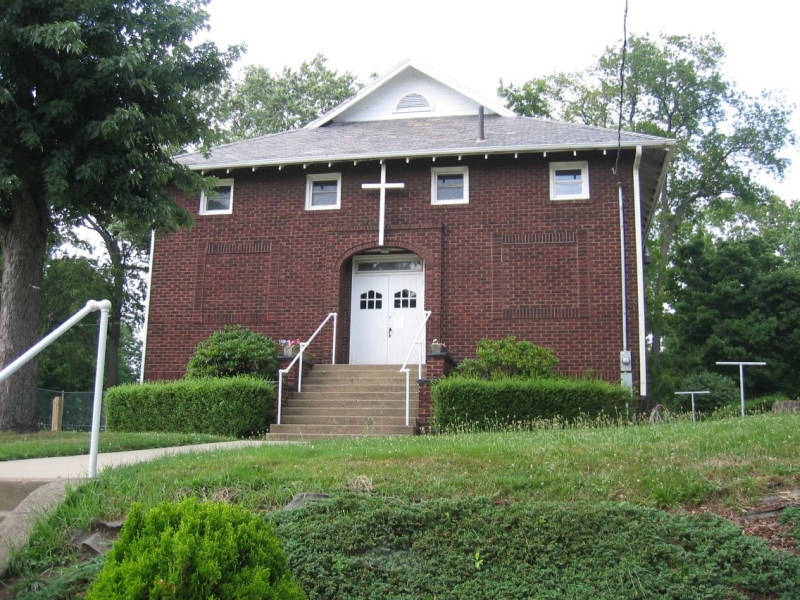
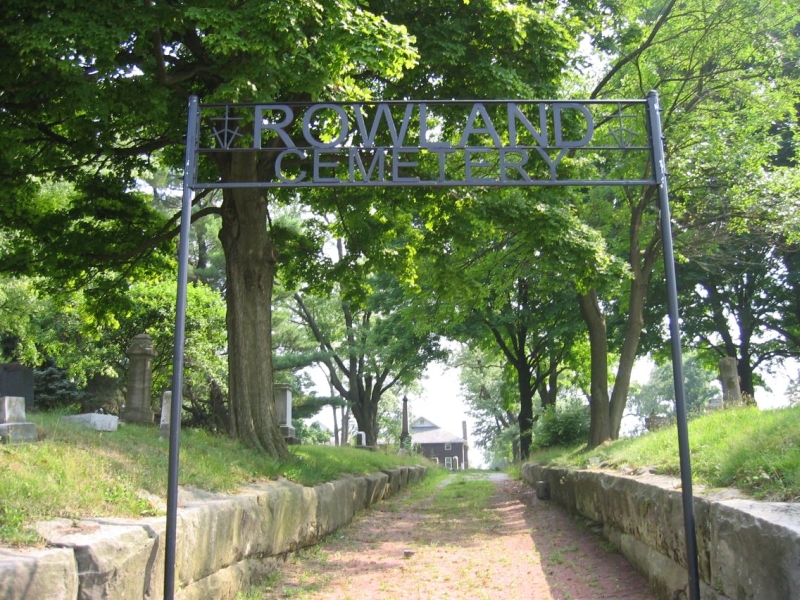
1832 Joseph Rohrer of Stark County, Ohio, son and heir of David Rohrer, late of East Hempfield Twp, Lancaster County, released claims against John Rohrer and Christian Steinman, administrators of the will of David Rohrer. Dated November 10. [32]
1835 Joseph Rohrer was taxed for 5 horses and 9 cows and land in Plain Twp, Stark County, Ohio in the southwest part of section 36 of Twp 11 of Range 8 with 154.5 acres valued at $737. This section 36 appeared on a map of Stark County from about 1865 as owned by J Bowers and adjacent to land owned by Shirk, Hoffman, Beese, Becher, and Souder. The land appears to be just across the street (perhaps a bit east) from the Rowland church. Joseph also owned town lots 157-59 in Canton, Stark County, Ohio.
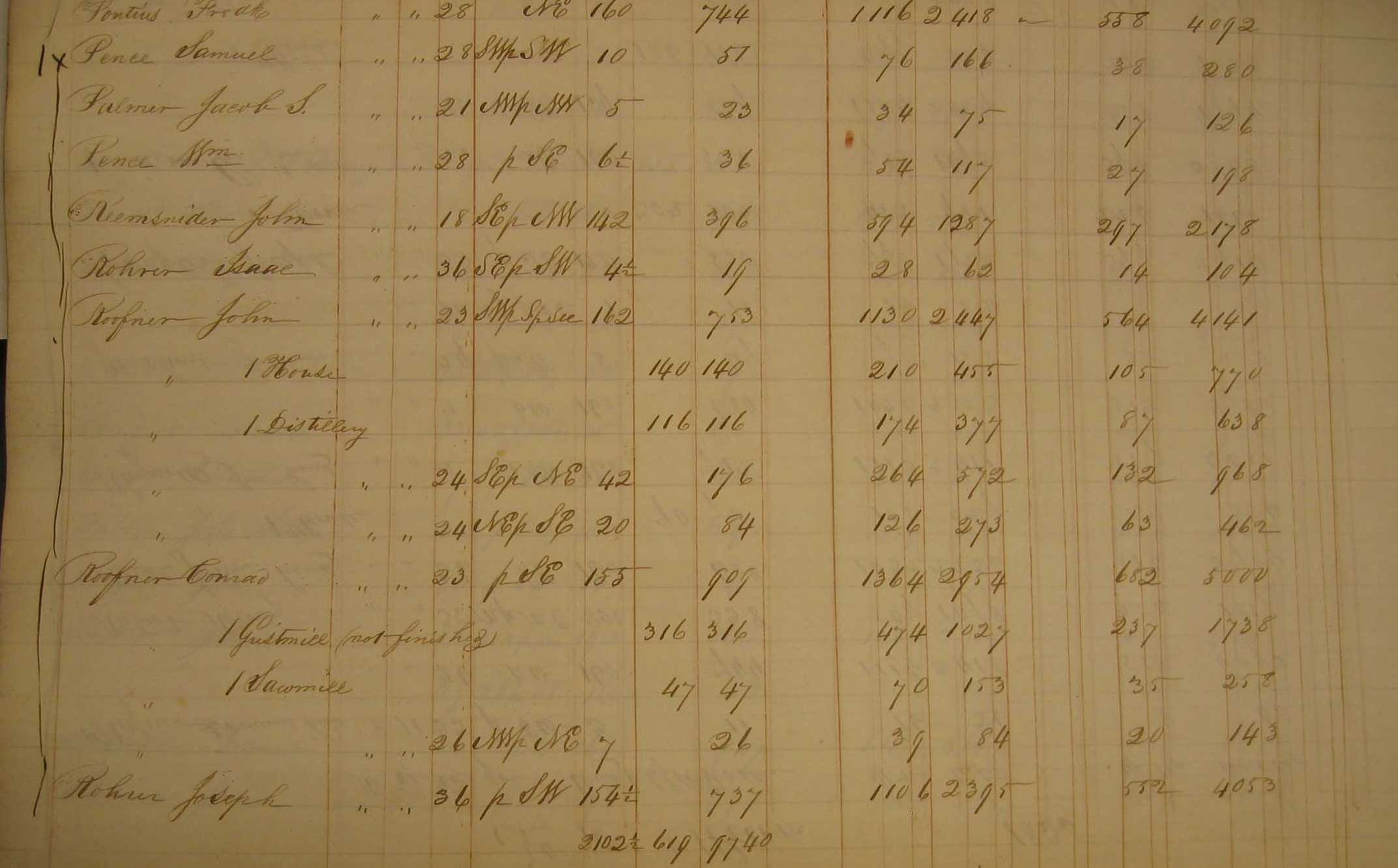
1838 Mary Rohrer, wife of Joseph Rohrer of Stark County, Ohio, wrote a notarized letter to establish her share of the estate of her father, Henry Forry, of York County, Pennsylvania. [Photocopy, From the estate documents of Henry Forrer.]
1840 Joseph Rohrer (age 30-40) lived with 4 other males ages 0-5 (Henry), 5-10 (Samuel), 10-15 (son Joseph), and 20-30; two females age 0-5 (Mary and Susanna) and one female age 5-10 (Martha), and a female age 40-50 (wife Mary) in Plain Twp, Stark County, Ohio. [33] [34]
1844 Joseph Rohrer was taxed for 4 horses and 14 cows in Plain Twp, Stark County, Ohio. [35]
1845 John Rohrer of Wayne County, Ohio; Mary Rohrer, and her husband Isaac Rohrer, of Stark County Ohio; and Joseph Rohrer of Stark County, Ohio were represented by their attorney, David Rohrer of Hancock County, Ohio, as four children of Mary Rohrer, deceased, who was daughter of Jacob Sherrek senior, regarding the estate of Jacob Sherreck, the younger. [36]
1845 Joseph Rohrer was taxed for 4 horses, 10 cows, a house on a 60 acre lot and a 152 acre lot in the SW part of section 36 in Plain Twp, Stark County, Ohio. [37]
1847 Joseph Rohrer was mentioned in a newspaper clipping, dated September 2, as owning 100 acres in section 36, township 11, range 8 (Stark County, Ohio), adjacent to land sold in a Sheriff's sale. [38]
1848 The first Mennonite settlers of Elkhart County, Indiana worshiped in the log meetinghouse on the farm of Bishop Martin Hoover. Joseph Rohrer would move from Stark County, Ohio to Elkhart County, Indiana about 1850. [39]
1849 Joseph Rohrer was taxed for a house on a 60 acre lot (NW) and a 152 acre lot (SW) in section 36 in Plain Twp, Stark County, Ohio. [40]
1850 Joseph Rohrer (age 49, born Pennsylvania) and Mary Rohrer (age 50, born Pennsylvania) lived in Plain Twp, Stark County, Ohio [41] [42]. Joseph was a farmer with estate valued at $8320. They lived with children Joseph Rohrer (age 20, farmer), Henry Rohrer (age 18), Martha Rohrer (age 17), Samuel Rohrer (age 15, farmer), Mary Rohrer (age 13), Susan Rohrer (age 11), Anna Rohrer (age 9), and John Rohrer (age 8), all listed as born in Ohio, perhaps an error for oldest son Joseph, who may have been born in Pennsylvania.
1845-48 Son, Joseph J Rohrer, lived in sections 27 or 34 of Harrison Twp, Elkhart County, perhaps, after 1850. Descriptions of land owned by Martin Hoover and Dr. Weldy, later owned by Joseph Rohrer (perhaps son, Joseph J. Rohrer), southwest of Goshen, could refer to land in sections 27 and 34. We have yet not seen Elkhart county land deeds of this era.
1845 "in the spring of 1845, Bishop Martin Hoover, then already 85 years old, with his son, John, settled on the farm now occupied (published 1888) by Joseph Rohrer, a short distance north of South West." [43]
1848 "In the spring of 1848 Christian Christophel, Jacob Christophel and Jacob Wisler, with their families, from Columbiana County, Ohio, joined the little colony; the latter two were ministers of the Gospel, and on Ascension Day in that year they appointed and held their first meeting, in the old log school-house, on the northwest corner of the farm on which Joseph Rohrer is now living (published 1888)" [44]
1850 Joseph Rohrer (age 47, born in Pennsylvania) lived in Plain Twp, Stark County, Ohio, in a household with Mary Rohrer (age 50), Joseph Rohrer (age 20), Henry Rohrer (age 18), Martha Rohrer (age 17), Samuel Rohrer (age 15), Mary Rohrer (age 13), Susan Rohrer (age 11), Anna Rohrer (age 9), and John Rohrer (age 8). Joseph Rohrer was a farmer. [45]
c 1852 The Rohrer family moved to Indiana in a covered wagon, according to daughter Susan's obituary.[46]. Joseph Rohrer moved to Harrison Township in 1850 settling on the farm later owned by Dr. Maurice L and Irene Anna Weldy. [47] [48]
1844 Map. Transport from Stark County, Ohio (Bottom-right) to Elkhart County, Indiana (Top-left). [49]A biosketch reported that Joseph Rohrer settled on a 155 acre farm 6 miles southwest of Goshen in Harrison Twp, Elkhart Indiana known as the "Maurana" farm, later owned by Dr. M.L. Weldy, for $1.33 per acre [50].
"The Mennonite settled in Elkhart county (of which Goshen is the seat) in 1846. Among the names of those early settlers were John Smith, Martin Hoover, Joseph Rohrer, Christian Henning, Jacob Strohm, Christian and Jacob Christopher, Jacob Wisler, Benjamin Hershey, Daniel Moyer,...David Good, ... Some of the old-time pastors in Elkhart County were ... Peter Y Lehman ..." [51] [52]
1850 The first Mennonite settlers of Elkhart County, Indiana worshiped in a log meetinghouse on the Rohrer farm. [53] Joseph Rohrer preached with Bishop Jacob Wisler at the Yellow Creek Mennonite meetinghouse. Jacob Wisler was known as a very earnest preacher who stressed the "strait and narrow" way. Joseph Rohrer became exuberant in preaching, which displeased Bishop Wisler. After some disagreement with Wisler, Joseph Rohrer moved to the nearby Evangelical church [54]. A photo of the church at Yellow Creek Mennonite Church has been published. [55]
1854-59 Joseph and Mary Rohrer transferred land in Harrison Twp, Elkhart County to several of their children. The numbering of sections in these deeds (1854-59) does not correspond to the land patents listed in the Research Notes, below.
1854 John S. Detwiler (spouse of daughter Martha): 80 acres in west half of southeast quarter in Section 22, Twp 36, North of Range 5 East. [56]
1854 Henry Rohrer: 85 acres in northeast quarter in Section 34, Twp 36, North of Range 5 East. [57]
1854 Joseph Rohrer: southeast quarter of the northwest quarter in Section 34, and 70 acres from west side of the northeast quarter of section 34 in Twp 36, North of Range 5 East. [58]
1854 Samuel Trump, relationship unknown: section 3 of Twp 36. [59]
1855 David Hoover: 20 acres in northeast corner of the northwest quarter in Section 27 in Twp 36, North of Range 5 East. [60]
1859 Samuel Rohrer: east half of the southwest quarter in Section 22 in Twp 36, North of Range 5 East. [61] [62]
1857 Son Henry Rohrer died in Elkhart County, Indiana and left grandson David. Joseph Rohrer was listed as David's guardian. [63]
1860 Joseph Rohrer [Rhorer](age 59), farmer, and wife Mary Rohrer (age 60) lived in Harrison Twp, Elkhart County, Indiana with Samuel Rohrer (age 25), John Rohrer (age 19), Anna Rohrer (age 17), Elizabeth Rohrer (age 25)(daughter-in-law, wife of deceased son Henry), and (grand-son) David (age 3). [64] [65] Son Joseph Rohrer (age 30) was on the previous page of the census. [66]
1861 Joseph Rohrer and Mary had 8 children and reportedly gave each of them an 80 acre farm in Elkhart County, Indiana, or the money equal to a farm, when the children got married. On a plat map of Elkhart County, the farm of Joseph Rohrer (and Mary?) is shown in section 27, and the following tracts, possibly for their sons and sons-in-law, were also shown: David Hoover, John S Detwiler, and John F Rohrer in section 22; George Moyer in section 23; Henry Rohrer and Joseph Rohrer Jr in section 34. Samuel Rohrer and Peter Shamory reportedly took money instead of farms. [67]
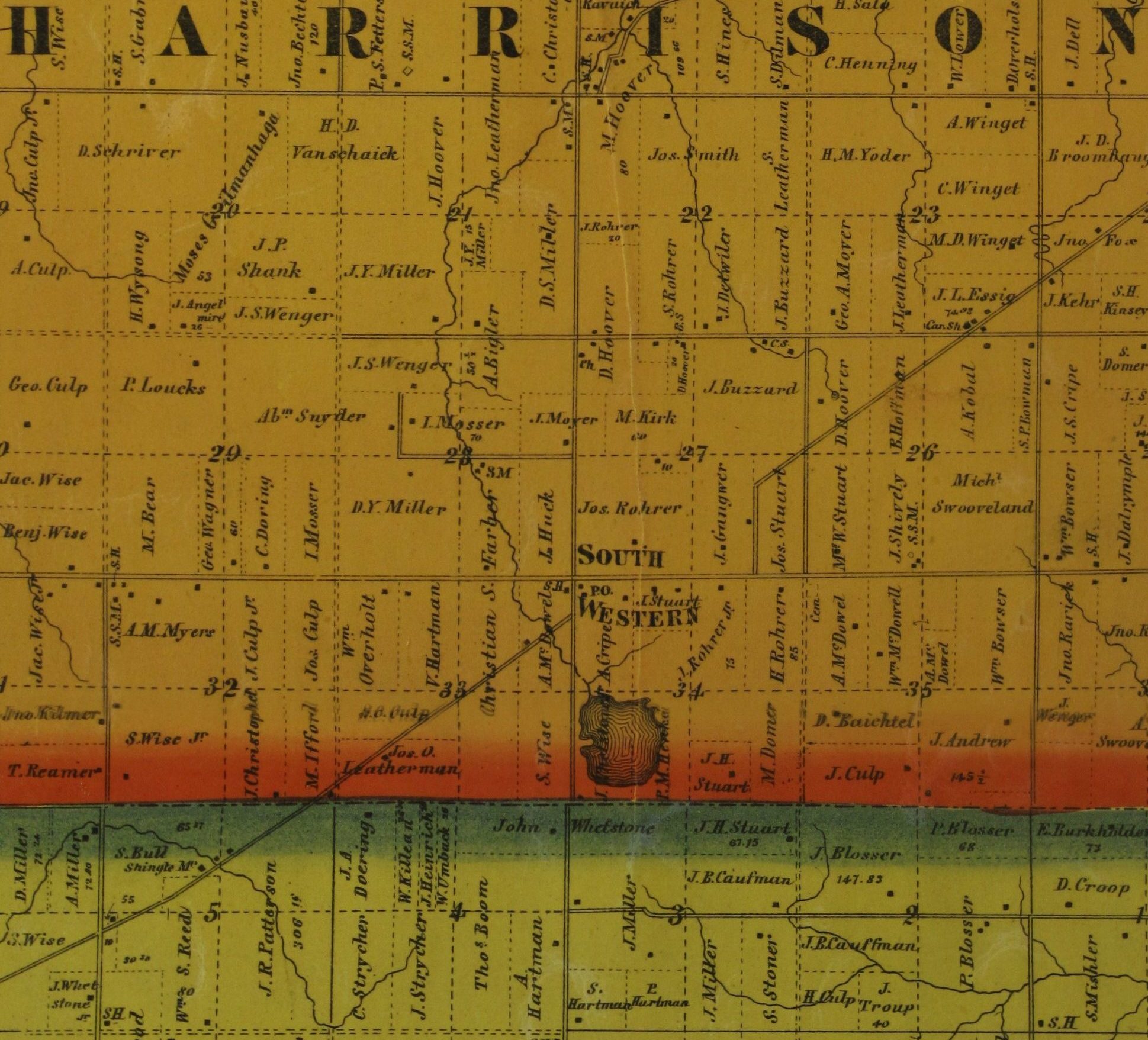
1870 Joseph Rohrer (age 68) lived in Elkhart Indiana with wife Mary Rohrer (age 70) and Anna Rohrer (age 30, born Ohio) and Anna Myers (age 10, born Indiana). [68] [69]
1874 Joseph Rohrer still owned the farm of 145 acres [J Rohrer in section 27], while son Joseph J Rohrer owned the nearby farm of 115 acres [JJ Rohrer, section 34], both near the Southwestern post office. J Rohrer also owned tracts in section 22 of Harrison Twp and section 1 of Union Twp. [70]
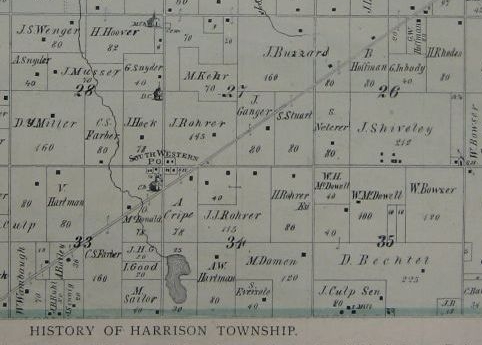
1880 Joseph Rohrer (age 79) and Mary Rohrer (age 80) lived in Harrison, Elkhart, Indiana with single daughter Anna Rohrer (age 40, born in Ohio). Living with them was Mary Bowers, a single, female, (age 18) servant. [71] [72]
1884 "Died, in Harrison township, June 6, 1884. Rev. Joseph Rohrer, aged 82 years, 7 months and 6 days. He leaves an aged companion, seven children, 45 grand children and 20 great grand children. Father Rohrer was born in Lancaster county, Pa., and moved to Elkhart county 34 years ago, where he resided till his death. He was a local preacher in the Evangelical Association since 1861, and died in great peace. Funeral and burial at Harrison Center chapel." [73] [74]
1884 Joseph Rohrer died on June 5, at age 82y 7m 7d and was buried at Harrison Chapel Cemetery, Goshen, Elkhart County, Indiana. [75] [76]
1885 Mary Rohrer died on November 22, at age 86y 10d, and was buried at Harrison Chapel Cemetery, Goshen, Elkhart County, Indiana. [77] [78]
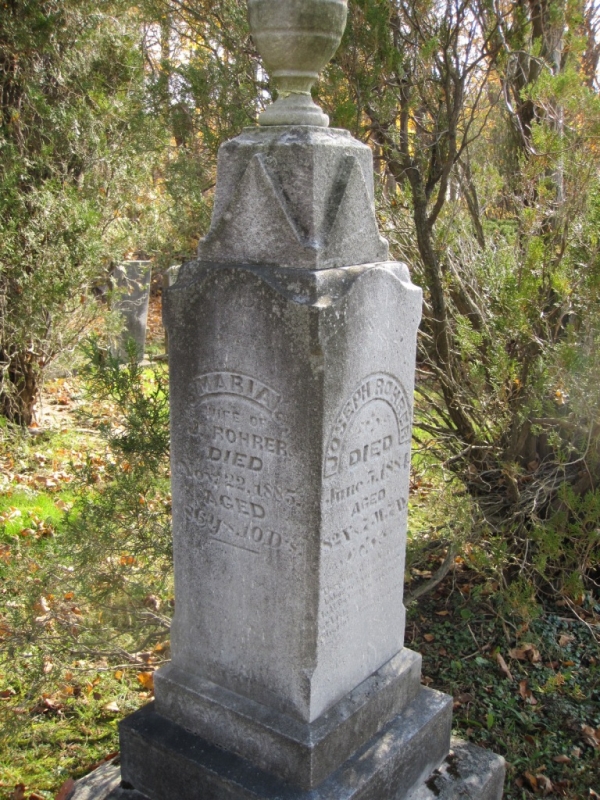
Joseph's preaching style and the politics and history of his church in Indiana have been described [80], with excerpts here:
Old Order Mennonites, a name applied to certain conservative groups which separated from the Mennonite Church (MC) in the United States and Canada 1872-1901, maintaining the "Old Order" of customs of worship and church life. ... These four groups originated through a reluctance to accept cultural change, and the determination not to adopt the newer agencies for Christian education and evangelism such as the Sunday school, series of evangelistic meetings, and similar new activities and institutions.
Jacob Wisler (1808-89), ordained preacher in Columbiana County, Ohio, in 1833, moved to Elkhart County in 1848, and the year after the death of the aged Martin Hoover (c1761-1850) he was ordained bishop by Abraham Rohrer of Medina County, Ohio, the bishop who had ordained Hoover in 1845 just before he migrated to Elkhart County. Wisler, of a conservative turn of mind, was opposed to any change in the life of the church. Joseph Rohrer (1801-84), a preacher of Stark County, Ohio, came to Elkhart County in 1850, and served for some time in the ministry with Wisler. But Wisler did not like the exuberance manifested by Rohrer as he preached, and accused him of having too much of a "Methodist" spirit. Rohrer finally left the church and united with the Evangelical Church, whose house of worship stood one-half mile north of the Yellow Creek Mennonite meetinghouse, eight miles west of Goshen. In 1864 Daniel Brenneman, also a preacher, moved from Ohio to Elkhart County, a man similar in spirit to Joseph Rohrer, and was soon, like Rohrer, more popular than the bishop. Brenneman was happy to preach in English and he did not hesitate to sing a strong bass in the Yellow Creek services, although he knew that Wisler favored the old unison singing. A deacon of the Holdeman congregation, Joseph Holdeman, was also critical of Wisler as well is of a number of other leaders through the years. There was considerable dissatisfaction in the church by 1867, the year when John F. Funk located in Elkhart County. In October 1867 a committee of 16 leaders from Ontario, Ohio, Pennsylvania, Illinois, and Virginia attempted to adjust the difficulties. The first signer of the Committee of Sixteen was Joseph Hagey of Ontario. The next year, 1868, Dman Moyer of Ontario made another effort to iron out the difficulties, and he signed his statement "In the presence of Joseph Hagey." In 1869 Tillman Moyer was back again, accompanied by two Ontario and two Ohio Mennonite leaders, and another effort was made to establish permanent peace. In 1870 Bishop John M. Brenneman of Ohio, the strongest leader in the state, came to Elkhart County with the express approval of Bishop Rohrer, who had ordained Wisler and who had served on the Committee of Sixteen in 1867, and Brenneman succeeded in once more effecting peace. But Wisler's dissatisfaction with the Indiana Conference's approval of Sunday schools in 1870 led to fresh trouble in 1871, and in October 1871 a committee of six bishops headed by John M. Brenneman suspended Wisler's bishop function, with the approval of the Yellow Creek congregation. Wisler rejected the decision of the Committee of Six, and on 6 January 1872, the Elkhart County ministers announced to the Yellow Creek congregation that Wisler and his followers, including preachers John Weaver and Christian Bare, were no longer members of the church.
A biosketch reported [81] [82]:
Joseph [Rohrer] was a better than average preacher and consequently was asked to preach most of the funerals. The Bishop of the church became jealous of him and one day after Joseph had given a fine sermon, the Bishop reprimanded him before the Board of Elders by saying that he got too happy while preaching. This disgusted Joseph, so he left the Mennonite Church and joined the Evangelical Church, where he could preach undisturbed and get as happy as he wished. He and his family stayed with the Evangelical Church and that is why he was buried at the Evangelical Cemetery (the cemetery has also been called the "Chapel Cemetery" or the "Evangelical Chapel Cemetery" or the "Harrison Chapel Cemetery"). His wife, five children and several grandchildren are buried there too. (The church building was moved to Elkhart and reportedly still stands there in 1994 and is used for a church.)
A biosketch reported [83]:
Joseph Rohrer, 1801-1884, preacher, Yellow Creek
Born near Mountville, West Hempfield Township, Lancaster County, Pennsylvania, in October 1801, first cousin of Bishop Abraham Rohrer, 1788-1878, of Medina County, Ohio. Married Mary Forey (1799-1885) in 1828. Eight children. Removed from Lancaster County, Pennsylvania, to Stark County Ohio, in 1830, and settled about 2 miles east of Canton, where they lived for 20 years. Ordained preacher at the Rowland Mennonite church (now the first Mennonite Church, Canton) about 1830. Removed in 1850 to Harrison Township, Elkhart County, Indiana, 6 miles southwest of Goshen, on the present "Maurana" farm of Dr. M.L. Weldy. The first Mennonite settlers of Elkhart County worshipped in a log meeting house on his farm for a time. Rohrer was a very earnest preacher who stressed the "strait and narrow way". He became somewhat exuberant in preaching, which displeased Bishop Jacob Wisler who felt that Rohrer had too much of a "Methodist spirit". He finally insulted Rohrer, and either expelled him, or succeeded in getting him to leave. Rohrer then united with the Evangelical Church. He was the son of David Rohrer, who in turn was the son of immigrant John Rohrer, 1700-1772. Died June 5, 1884, at the age of 82. Burial in the cemetery of the Evangelical Church, a short distance north of the new Harrison Township School.
1903 Joseph J Rohrer, widowed, spouse of Hariet Rohrer, died on November 25, at age 74, in Harrison Twp, Elkhart County, Indiana. He was born on December 24, 1829, in Penn, son of Joseph and Meriah Fory. [84] [85]
1908 Daughter Mrs Annie Shamory, married, spouse of P M Shamory, died on March 3, at age 67, in Elkhart, Elkhart County, Indiana. She was born on February 15, 1840, in Stark County, Ohio, daughter of Joseh Rohrer and Maria Fory. [86] [87]
1923 Son John F Rohrer, widowed, died on May 19, at age 80, in Elkhart Twp, Elkhart County, Indiana. He was born on October 30, 1842, in Penn, son of Joseph Rohrer and Mary Rohrer. [88] [89]
1934 Susannah Hoover, widowed, died on May 5, at age 94, in Wakarusa, Elkhart County, Indiana. She was born on May 20, 1839, in Stark County, Ohio, daughter of Joseph Rohrer and Forey. [90] [91]
Research notes:
1801 Joseph Rohrer was reported born near Mountville, West Hempfield, Lancaster County, Pennsylvania. Joseph Rohrer was a son of David Rohrer, son of emigrant John Rohrer (1700-1772), and Mary Sherch [92]. Family tradition [93] indicated that Joseph's father, John Rohrer, had settled on a grant of land in Lancaster County, Pennsylvania and that Joseph Rohrer was born there.
See also: [94]
1828-41 There was another Joseph Rohrer who settled in St. Joseph County, Indiana in 1829. Joseph Rohrer, who settled in St Joseph county in the 1830s, was one generation older than Joseph Rohrer of Harrison Twp, Elkhart County, since Samuel Leeper married the daughter of Joseph Rohrer of St Joseph in 1828. South Bend is in St. Joseph County. Goshen is in Elkhart County.
An obituary for David Rohrer Leeper reports [95]:
The interment will be in the Rohrer cemetery. … Mr. Leeper's father was Samuel Leeper … who … removed to Stark County, Ohio, and … to Montgomery County … where in 1828 he married Elizabeth Rohrer … The Rohrers were Pennsylvanians of German extraction. One of their ancestors, the Schauers, on the maternal side … Sameul Leeper, in company with his father-in-law, Joseph Rohrer, who was a conspicuous figure in the early history of this county, first visited the St. Joseph Valley in August, 1829. …
Joseph Rohrer, of St. Joseph County, received patents for land in Elkhart County, Indiana. The numbering of sections in the deeds (1854-59) made by Joseph Rohrer, of Harrison Twp, Elkhart County in the notes above does not correspond to the land patents. Joseph Rohrer, of Harrison Twp, Elkhart County, moved to Indiana in about 1850, so perhaps all of these land patents relate to a different Joseph Rohrer, of St. Joseph County.
1831 Joseph Rohrar, of St. Joseph County, Indiana, made 14 purchases of 80 acres each in sections 37 and 38 of St. Joseph County, Indiana (adjacent to Elkhart County), all deeded by President Andrew Jackson. Dated March 1. [96] [97] [98]
1837 Joseph Rohrer of St. Joseph County, Indiana purchased two tracts of 80 acres in St. Joseph County and Elkhart County, Indiana; dated March 15. [99] [100] [101]
1837 Joseph Rohrer of St. Joseph County, Indiana purchased 7 lots, each of 80 acres, in sections 19, 20, and 23 of Twp 37 [Baugo Twp], of Elkhart County; dated March 20. All were deeded by President Martin van Buren. [102] [103] [104] [105]
1828 Joseph Rohrer, of Stark County, Ohio, was near South Bend, Indiana with son-in-law Samuel Leeper: "His father was Samuel Leeper, who early in life removed from his home in Washington County, Pennsylvania, to Stark County, Ohio, and afterward to Montgomery County, in that state. His mother was Elizabeth Roher, who also resided in Montgomery County. In 1828 his father first came to St. Joseph County. Indiana, in company with his father-in-law, Joseph Rohrer, but did not remain. He returned, however, in 1830, and pitched his tent on the bank of McCartney creek, west of the present city, where the Michigan road crosses the creek, while the surrounding country was the hunting ground and the habitation of the Indians. His first shelter was the cover of his wagon, stretched upon upright poles, and later he erected a rude log cabin as a dwelling for his family." [106]
"David Rohrer Leeper. Samuel Leeper, the father of the subject of this sketch, was a native of Washington county, Penn.; but in early life removed with his parents to Stark County, Ohio. While yet a lad, he found his way to Montgomery county, in the same State, where in 1828 he was married to Elizabeth Rohrer. The name Leeper is supposed to be Irish; such is the family tradition, and this is partially substantiated by the fact that the name is found in early Dublin records. The present branch of the family was intermarried with the name Kent, thus showing an admixture of English blood. The Rohrers were Pennsylvanians of German extraction. One of the ancestors, Schauers, on the maternal side, came to America during the Revolution. It is not known when the others in the ancestral lines crossed the ocean, but it must have been at a very early date. The family record is very meager and obscure beyond the third generation from the present subject. The families on both sides were Protestant as far back as the record is known. Samuel Leeper, in company with his father-in-law, Joseph Rohrer, who was quite a conspicuous figure in the early history of this county, first visited the St. Joseph Valley in August, 1829. He was so impressed with the beauty and fertility of the country that early in the following year he removed hither with his family from Montgomery county, Ohio, arriving early in March. Gen. Wayne had built a road part of the distance, but the balance of the way was marked only by Indian trails, there being no bridges or ferry-boats on any of the streams. The hardships and perils encountered on the route furnished subjects which he was prone often to recount in after life. Mr. Leeper first pitched his tent on the left bank of the McCartney Creek, which runs across the westerly quarter of the present city of South Bend. The site was a few rods north of where the Michigan road now crosses that stream." [107]
1831 "Joseph Rohrer and his family were living under a shed on the lot now occupied by James Henry." [108]
1831 South Bend was chosen as the county seat of St. Joseph County, Indiana. Joseph Rohrer was a county commissioner. [109] [110] [111]
1841 Martin Light Wenger visited South Bend and reported, in his diary: "Then continuing south on the Michigan road, were the places of John Rohrer, Andrew Moiling, the Ullerys and others. West of the Michigan road was the Rupel settlement. where lived the family of Peter Rupel. father of Elisha and Basil Rupel. and Samuel Rupel. father of William Rupel. of this city; also H. C. Webster and John Johnson. On the Turkey Creek road, three miles out. lived Joseph Rohrer on the place now owned by Samuel Leeper. Jr. Mr. Rohrer was an extensive land owner; at one time he owned a body of land two miles long and one-half mile wide of the best land in Center township. A few miles north from him lived his son, David Rohrer, father of John Rohrer, of this city." [112]
1866 The land of Rohrer was shown in sections 25 of Portage Twp (John Rohrer and Laura Rohrer), and section 30 of Penn Twp (John Rohrer Jr), St Joseph County, Indiana. [113]
Jos. Rohrer (age 47) was listed as a "first settler" in Elkhart, Indiana with date of immigration 1832 as were Mrs. Rohrer (age 63), John Rohrer (age 53), and Mrs. Rohrer (age 52), all of Ohio, and all members of the Elkhart Pioneer Society. [114]
[1] Find A Grave Memorial 69716225, [FindAGrave].
[2] United States Federal Census, 1850, reports birth in Pennsylvania, [FamilySearchImage], [FamilySearchRecord].
[3] Pennsylvania, U.S. Direct Tax Lists, 1798, Hellam, list 1, line 18, [AncestryRecord], [AncestryImage].
[4] Pennsylvania, U.S. Direct Tax Lists, 1798, Hellam, list 2, line 28, [AncestryRecord], [AncestryImage].
[5] Pennsylvania, U.S. Direct Tax Lists, 1798, [AncestryRecord], [AncestryImage].
[6] United States Federal Census, 1800, page 1318, [FamilySearchImage], [FamilySearchRecord].
[7] Find A Grave Memorial 69716193, [FindAGrave].
[8] US census, 1850, Reel 0731, Image 103, family 314, [InternetArchive].
[9] United States Federal Census, 1850, age 49, born Pennsylvania, [FamilySearchImage], [FamilySearchRecord].
[10] John Christian Wenger, The Mennonites in Indiana and Michigan (1961), 321, Reports birth in October 1801, at West Hempfield, Lancaster County, [GoogleBooks].
[11] United States Federal Census, 1800, Census record for Hempfield Twp, Lancaster County, [AncestryImage], [AncestryRecord].
[12] United States Federal Census, 1810, [FamilySearchImage], [FamilySearchRecord].
[13] United States Federal Census, 1810, [AncestryImage], [AncestryRecord].
[14] John Christian Wenger, The Mennonites in Indiana and Michigan (1961), 321, [GoogleBooks].
[15] Goodspeed Brothers, publishers, Pictorial and biographical memoirs of Elkhart and St. Joseph counties (1893), 574, names Susanna Rohrer as a daughter of Joseph Rohrer and Mary Ferry, [GoogleBooks], [HathiTrust].
[16] Lancaster Mennonite Historical Society, Genealogical Card File (Lancaster, Pennsylvania), [AncestryRecord], [AncestryImage].
[17] Lancaster Mennonite Historical Society, Genealogical Card File (Lancaster, Pennsylvania), [AncestryRecord], [AncestryImage].
[18] Wikipedia article about Columbia%E2%80%93Wrightsville_Bridge, content subject to change, [Wikipedia].
[19] Nathaniel Parker Willis, Picturesque American Scenery: A Series of Twenty-five Beautiful Steel Engravings (1883), 88 next page, [GoogleBooks].
[20] John Kilbourn, Public documents concerning the Ohio canals (1832), 145, right column, extract of letter, [HathiTrust].
[21] Indiana, U.S., Death Certificates, 1899-2011, [AncestryImage], [AncestryRecord].
[22] United States Federal Census, 1830, [AncestryImage], [AncestryRecord].
[23] US census, 1830, Reel 0153, Image 639, line 7, [InternetArchive].
[24] Amos Lay, Map of the United States compiled from the latest and most accurate surveys by Amos Lay, geographer & map publisher, New York (1834), [LibraryOfCongress], [LibraryOfCongressCatalog].
[25] John Christian Wenger, The Mennonites in Indiana and Michigan (1961), 321, [GoogleBooks].
[26] Thomas A. Sherk and James W Sherrick, "Joseph Scherch, Immigrant of 1727, and His Descendants," Pennsylvania Mennonite Heritage 13 (July, 1990), 17-29, at 25, C216.
[27] John Christian Wenger, The Yellow Creek Mennonites: The Original Mennonite Congregations of Western Elkhart County (1985), 149, [GoogleBooks].
[28] Archives of Akron University, Akron, Ohio.
[29] John Christian Wenger, The Mennonites in Indiana and Michigan (1961), 62, 321, [GoogleBooks].
[30] William Henry Perrin, ed., History of Stark County, with an Outline Sketch of Ohio (Baskin & Battey, 1881), 372, [InternetArchive].
[31] Global Anabaptist Mennonite Encyclopedia Online First_Mennonite_Church_of_Canton_(Canton,_Ohio,_USA), content subject to change, [GlobalAnabaptistEncyclopedia].
[32] Lancaster County, Pennsylvania, Deed W5-187 to 188, [FamilySearchImage], [FHLCatalog].
[33] United States Federal Census, 1840, page 88A, [FamilySearchImage], [FamilySearchRecord].
[34] United States Federal Census, 1840, [AncestryImage], [AncestryRecord].
[35] Archives of Akron University, Akron, Ohio.
[36] Recorder of Deeds, Lancaster County, Pennsylvania, Deed Book A7, 307-308, [307], [308], [FHLCatalog].
[37] Archives of Akron University, Akron, Ohio.
[38] Newspaper, Ohio Repository, 2 September, 1845.
[39] Daniel K. Cassel, History of the Mennonites (1888), 159, [InternetArchive].
[40] Archives of Akron University, Akron, Ohio.
[41] US census, 1850, Reel 0731, Image 103, family 314, [InternetArchive].
[42] United States Federal Census, 1850, [FamilySearchImage], [FamilySearchRecord].
[43] Daniel K. Cassel, History of the Mennonites (1888), 159, [InternetArchive].
[44] Daniel K. Cassel, History of the Mennonites (1888), 159, [InternetArchive].
[45] United States Federal Census, 1850, [AncestryImage], [AncestryRecord].
[46] William Henry Perrin, ed., History of Stark County, with an Outline Sketch of Ohio (Baskin & Battey, 1881), 372, [InternetArchive].
[47] John Christian Wenger, The Mennonites in Indiana and Michigan (1961), 62, [GoogleBooks].
[48] John Christian Wenger, The Yellow Creek Mennonites: The Original Mennonite Congregations of Western Elkhart County (1985), 73, [GoogleBooks].
[49] John Calvin Smith, Guide through Ohio, Michigan, Indiana, Illinois, Missouri, Wisconsin & Iowa (1844), [LibraryOfCongress], [LibraryOfCongressCatalog].
[50] John Christian Wenger, The Mennonites in Indiana and Michigan (1961), 321, [GoogleBooks].
[52] Newspaper, Fort Wayne Sentinel, August 6, 1915, page 14.
[53] John Christian Wenger, The Mennonites in Indiana and Michigan (1961), 321, [GoogleBooks].
[54] John Christian Wenger, The Yellow Creek Mennonites: The Original Mennonite Congregations of Western Elkhart County (1985), 73, [GoogleBooks].
[55] John Christian Wenger, The Mennonites in Indiana and Michigan (1961), 256, [GoogleBooks].
[56] Elkhart County, Indiana, Deeds, Access limited to Family History Centers, 18-240, [FamilySearchImage], [FHLCatalog], [Website Image].
[57] Elkhart County, Indiana, Deeds, Access limited to Family History Centers, 18-261, [FamilySearchImage], [FHLCatalog], [Website Image].
[58] Elkhart County, Indiana, Deeds, Access limited to Family History Centers, 18-261, [FamilySearchImage], [FHLCatalog], [Website Image].
[59] Elkhart County, Indiana, Deeds, Access limited to Family History Centers, 18-241, [FamilySearchImage], [FHLCatalog], [Website Image].
[60] Elkhart County, Indiana, Deeds, Access limited to Family History Centers, 20-495, [FamilySearchImage], [FHLCatalog], [Website Image].
[61] Elkhart County, Indiana, Deeds, Access limited to Family History Centers, 22-411, [FamilySearchImage], [FHLCatalog], [Website Image].
[62] Elkhart County, Indiana, Deeds, Access limited to Family History Centers, 22-412, [FamilySearchImage], [FHLCatalog], [Website Image].
[63] Rootsweb file, Henry Rohrer, Joseph Rohrer Guardian, [Rootsweb].
[64] United States Federal Census, 1860, family 808, [FamilySearchImage].
[65] United States Federal Census, 1860, [AncestryImage], [AncestryRecord].
[66] United States Federal Census, 1860, family 802, [FamilySearchImage].
[67] Family Document, Letter from Metzler.
[68] United States Federal Census, 1870, [AncestryImage], [AncestryRecord].
[69] United States Federal Census, 1870, [FamilySearchImage], [FamilySearchRecord].
[70] Higgins, Belden & Co., An Illustrated Historical Atlas of Elkhart County, Indiana (1874), [David RumseyMaps].
[71] US census, 1880, Reel 0275, Image 411, family 188, [InternetArchive].
[72] United States Federal Census, 1880, [FamilySearchImage], [FamilySearchRecord].
[74] Newspaper, Goshen Times, June 12, 1884, page 8, column 2.
[75] Find A Grave Memorial 69716193, [FindAGrave].
[76] Find A Grave Memorial at Ancestry.com, [AncestryRecord].
[77] Find A Grave Memorial 69716225, [FindAGrave].
[78] Find A Grave Memorial at Ancestry.com, [AncestryRecord].
[79] Family Document, Robert Wolfe, photographer. (2009).
[80] Global Anabaptist Mennonite Encyclopedia Online Old_Order_Mennonites, content subject to change, [GlobalAnabaptistEncyclopedia].
[81] Newspaper, Elkhart Truth (Elkhart, Indiana), October 1989), 11-12, Donald M. Rohrer. "Research".
[82] John Christian Wenger, The Yellow Creek Mennonites: The Original Mennonite Congregations of Western Elkhart County (1985), 73, [GoogleBooks].
[83] John Christian Wenger, The Mennonites in Indiana and Michigan (1961), 321, [GoogleBooks].
[84] Indiana, U.S., Death Certificates, 1899-2011, [AncestryImage], [AncestryRecord].
[85] Indiana, U.S., Death Certificates, 1899-2011, [AncestryImage], [AncestryRecord].
[86] Indiana, U.S., Death Certificates, 1899-2011, [AncestryImage], [AncestryRecord].
[87] Indiana, U.S., Death Certificates, 1899-2011, [AncestryImage], [AncestryRecord].
[88] Indiana, U.S., Death Certificates, 1899-2011, [AncestryRecord].
[89] Indiana, U.S., Death Certificates, 1899-2011, [AncestryRecord].
[90] Indiana, U.S., Death Certificates, 1899-2011, [AncestryImage], [AncestryRecord].
[91] Indiana, U.S., Death Certificates, 1899-2011, [AncestryImage], [AncestryRecord].
[92] Thomas A. Sherk and James W Sherrick, "Joseph Scherch, Immigrant of 1727, and His Descendants," Pennsylvania Mennonite Heritage 13 (July, 1990), 17-29, at 24, C216.
[93] Family Document, Metzler letter.
[94] John Christian Wenger, The Yellow Creek Mennonites: The Original Mennonite Congregations of Western Elkhart County (1985), 22, 30, Reports move in 1850 from Stark County, Ohio, conversion to Evangelical, burial site, and names wife Mary Forey, [GoogleBooks].
[95] Newspaper, The South Bend Tribune, South Bend, Indiana, Tuesday, November 27, 1900.
[96] United States Bureau of Land Management Patent, Section 33 in Twp 38N, [US_BLM Abstract], [Website Image].
[97] United States Bureau of Land Management Patent, Section 33 in Twp 38N, [US_BLM Abstract], [Website Image].
[98] United States Bureau of Land Management Patent, Section 14 in Twp 37N, John Rohrer is named on the deed, [US_BLM Abstract], [Website Image].
[99] United States Bureau of Land Management Patent, Section 19 in Twp 37N, [US_BLM Abstract], [Website Image].
[100] United States Bureau of Land Management Patent, Section 30 in Twp 36N, [US_BLM Abstract], [Website Image].
[101] United States Bureau of Land Management Patent, Section 19 in Twp 37N, [US_BLM Abstract], [Website Image].
[102] United States Bureau of Land Management Patent, section 23, Twp 37, [US_BLM Abstract], [Website Image].
[103] United States Bureau of Land Management Patent, section 19, Twp 37, [US_BLM Abstract], [Website Image].
[104] United States Bureau of Land Management Patent, section 20, Twp 37, [US_BLM Abstract], [Website Image].
[105] United States Bureau of Land Management Patent, section 23, Twp 37, [US_BLM Abstract], [Website Image].
[106] Anderson & Cooley, South Bend and the Men who Have Made it: Historical, Descriptive, Biographical (Tribune Printing Company, 1901), 169, [GoogleBooks].
[107] Goodspeed Brothers, publishers, Pictorial and biographical memoirs of Elkhart and St. Joseph counties (1893), 332, [GoogleBooks], [HathiTrust].
[108] History of St. Joseph County, Indiana; together with sketches of its cities, villages and townships (Chicago, C.C. Chapman & co., 1880), 611, [HathiTrust], [GoogleBooks].
[109] Timothy Edward Howard, A history of St. Joseph County, Indiana (Chicago, The Lewis publishing company, 1907), 174, right column, [HathiTrust].
[110] John B. Stoll, An account of St. Joseph county from its organization (Dayton, Ohio: Dayton Historical Publising Co., 1923), 39, [HathiTrust].
[111] History of St. Joseph County, Indiana; together with sketches of its cities, villages and townships (Chicago, C.C. Chapman & co., 1880), 686, [HathiTrust], [GoogleBooks].
[112] Christian M. Wenger, Wenger Memoirs and Autobiography of Martin Light Wenger and His Wife (1898), 58, [GoogleBooks].
[113] M. W. Stokes, Map of St. Joseph County, Indiana (Philadelphia: 1866), [LibraryOfCongress Map], [LibraryOfCongress Catalog].
[114] Charles C Chapman, publisher, History of Elkhart County Indiana (1881), 363, [HathiTrust], [GoogleBooks].